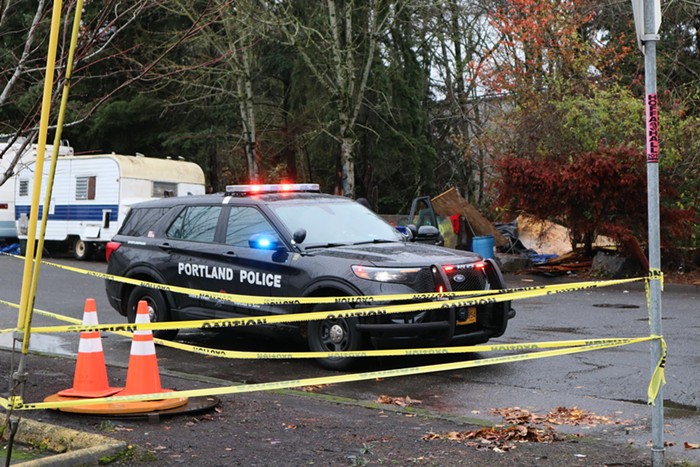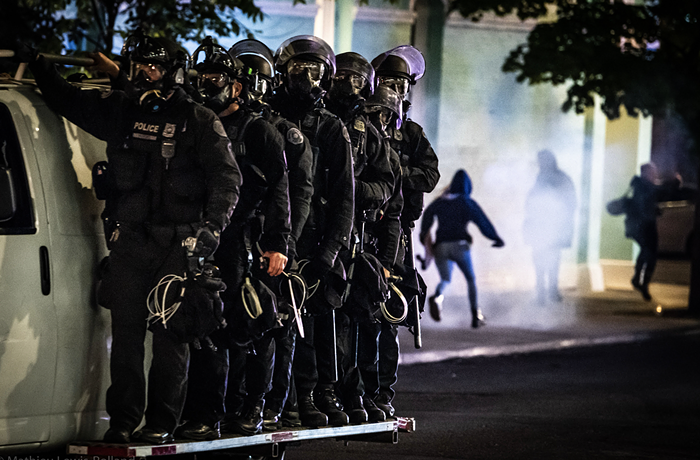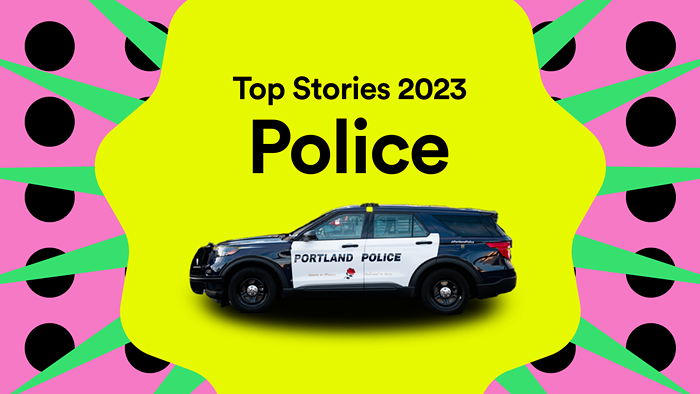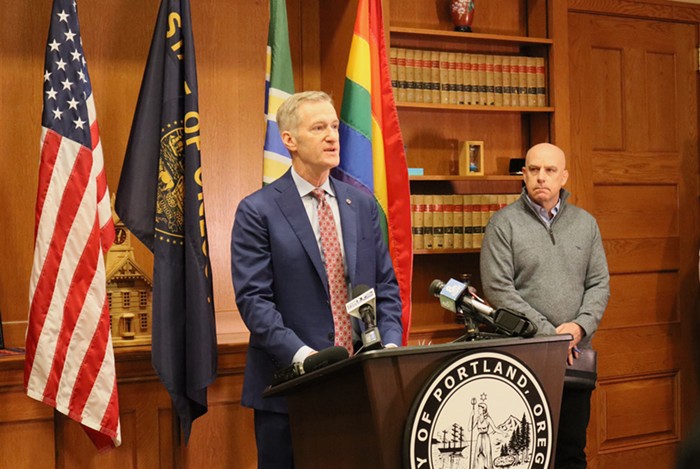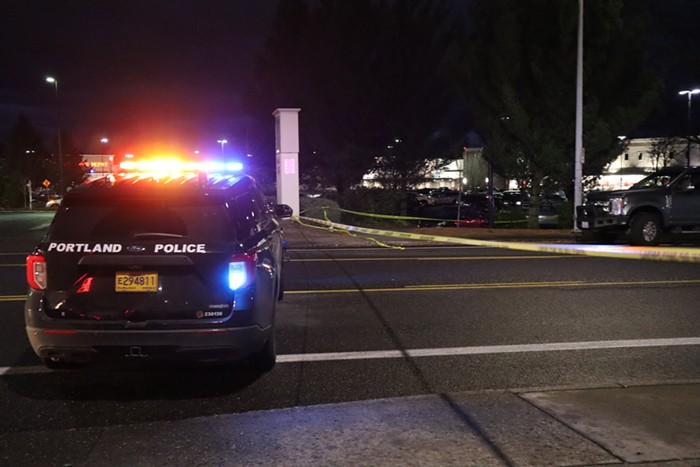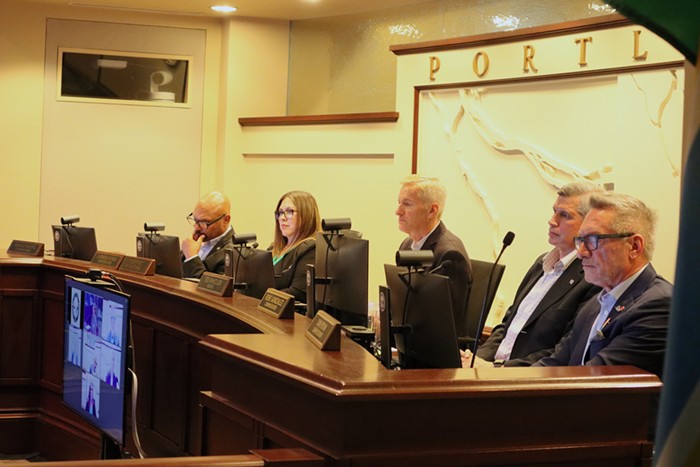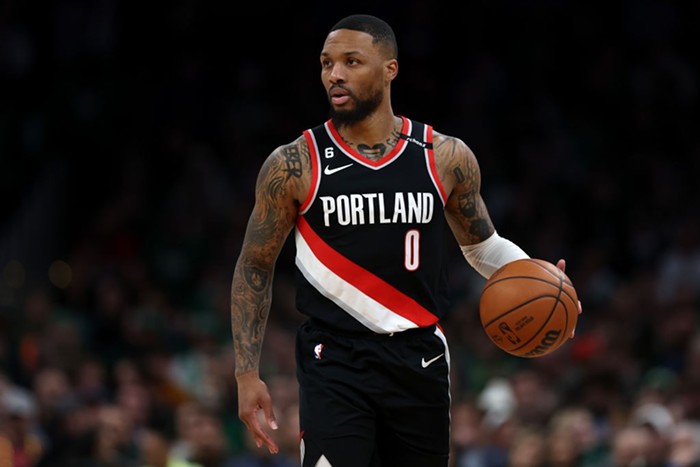Yesterday, the Portland Police Bureau issued a fretful statement about an unpermitted anti-violence-against-women rally and march planned for downtown at the (slightly) tender hour of 3 o'clock this afternoon.
And, coincidentally, it came just after Central Precinct Commander Bob Day, the bureau's point person for so-called crowd control, held forth for a Citizen Review Committee subgroup—quite candidly—on his philosophy for handling protests and keeping traffic moving.
Today's big event—one of many across the world—is called One Billion Rising, and it's launching from Director Park. Organizers here have been clear that they believe the issue they're marching for is too vital to require permission. Which falls into the situation Day described above. As such, the bureau's announcement came with CYA language in case things go sour:
The Portland Police Bureau has been in communication with event organizers but to date, the organizers are refusing to obtain a permit for the march and have stated that they may share the march route information but not until right before the event begins.
Rally and march organizers have further expressed that they will not comply with requests to remain on the sidewalks or stop for traffic signals.
"I had an epiphany," Day said at the sitdown. "If it were me trying to get home, I'd be frustrated. But then these people who are stuck drive by and they're waving and giving people the thumbs up. If they're okay with it, why does it matter than I'm not okay with it. But there are other people who are frustrated this unpermitted event is occurring, and they're going to be late."
"In some respects, it's not all that significant," Day also said of today's march. "On the other hand, this is a significant holiday for businesses. People want to go home and see their significant others on that. We're trying to balance all those needs out."
So look out downtown—and maybe show up and march. Because when enough people show up, permits and routes tend to matter even less. Cops back off and let the crowd mostly do what it wants. And if you want to read more thoughts from Day about policing protests and marches, what works and what doesn't, hit the jump.
On how the bureau plans for a major event—weighing time of day, day of the week, where the route might go, what people are saying on social media, and whether organizers refuse to communicate with cops.
"When we show up, we always go over and ask to talk to somebody in charge. But they say 'Nobody can speak for the group. We don't have to have a permit. It's free speech.' It's the same every time. We say, 'Here's what can be done.' They say, 'We'll do what we want.' Well, that will probably lead to conflict."
Day says he also looks at whether groups have "demonstrated" a history of confrontation. Tellingly, he made mention of the "anarchist movement."
"People make it clear they want a challenge with police. We have to weigh whether we want that challenge."
It's well-known that protesters with cameras are everywhere during marches and rallies, livestreaming for all the like-minded would-be marchers watching at home—or just ensuring there's a record in the event utter pandemonium erupts. The cops also have camera crews out at protests, and that's unsettled some.
"Typically we use the forensics evidence division. They'll assist us. It's not a blanket videotaping. It's specific things we want to capture, particularly when when it comes to arrests and things like that."
Day was later asked directly whether officers target protesters carrying cameras. Or signs bearing certain political messages.
"I have not heard complaints about that. This isn't personal. You can put up anything you want. I've been called a lot worse....
'If [an officer] were specifically targeting someone, I'd take issue with that. I won't say it's out of policy. I'd have to review that.... But I don't like independent action....
"Any officer today who has a problem with videotaping is just naive. You just have to expect that what you're doing is going to be videotaped. That's just life. That's just reality. If that's upsetting to you, you're going to have to get with the program. That's the reality of what we face."
Day was asked a few times about pepper spray—saying he thinks it's better than other weapons. He confirmed he gave permission to use the weapon against the high school kids protesting in Northeast last November. That step, permission, is an adaptation after the bureau, in years past, got in deep legal trouble over the indiscriminate use of the stuff.
"Pepper spray is a very effective tool to help get things back under control. There's limited long term impact or effect on folks."
On whether out-of-town cops should be made to wear name tags, in compliance with Portland's policy. Several outside agencies don't require it but have agreed to try harder when riding to the PPB's rescue. Except the Oregon State Police. They were kind of jerks about it. That said, Day won't tell 'em to stay away if he needs 'em.
"A name tag is fairly insignificant as far as a hill to die on. They should be wearing name tags," he said before going on, later, to explain: "I also don't want to minimize the name tag deal. But at the end of the day, it's a smaller piece than the overall behavior or the use of force."
On the use of the mounted patrol, stuck on the budget chopping block again, and whether the horses—seen by downtown boosters and others as friendly—are an agent of intimidation and harassment. Day says that's the point.
"I have a bias. I was on the mounted patrol unit for four years. Dan [Handelman, of Portland Copwatch, sitting in the room observing] filed a complaint against me when I was on the unit. It's a resource and an asset that needs to be handled appropriately. People say they're intimidating. I'd say, 'Yeah, that's one of the purposes to have them on scene, to say this behavior is no no longer appropriate, and we have resources that will prevent this behavior from occurring any further.
"They're very effective and non-confrontational method to help move crowds along. You can take five or six horses and move people without having nightsticks and so forth at the ready."
It's true, Day says, making clear that this is his own "personal philosophy" and not always the bureau's: Come with big numbers, and the cops might, out of necessity, have to step back and let the unpredictability of the crowd have its way, at least up to a point.
"Control is when we say this is what you can and can't do. Management is when we say, 'Hey, you guys are able to handle it, go ahead and handle it and we'll be available in case something gets out of line.'... "There are times when you'll have to go with management simply because of numbers."
Bikes are the bureau's best friend when it comes to keeping a lid on meandering marches where the route hasn't been shared ahead of time. Day minimized complaints, raised by CRC members, from several people who have filmed what seem like extreme uses of bicycle's as clubs and takedown devices.
"It does give us great mobility to be able to be responsive to situations. Crowds are so fluid....
As a barrier, there's an opportunity to create some space between a person and an officer, which is better than a face to face confrontation. In terms of using bikes to strike and push against people, those are all actions that are uses of force that are game-day decisions based on what's needed.
"If the group wants to push, they'll likely be pushing on bikes. You'd consider that as any other use of force. It's no different than if the officer was using his nightstick."
Day remembered the decision to let loose the masses penned up on SW Main between 5th and 4th after the final eviction of Occupy Portland from Chapman Square—ending what had been an extremely testy confrontation with several lines of riot cops.
"We can't stand here forever. We got the parks cleared. We've got the fencing up. We've got all these people, and they want to come our direction. We have to make a decision. We're not concerned about people charging over the fences. We made a decison to back off. The crowd started coming. I remember thinking 'I hope this was a good idea.' It just seemed like here comes everybody. But a few hundred went north, and a few hundred stayed. Those are the challenges we face in terms of making those decisions. I didn't see the need to do more of the old push and shove."
Day repeatedly talked about the balancing act he and his staff have to do when looking into events, and what they're larger job is. Is it the First Amendment rights of the protesters? Is it keeping order? Is it making sure protesters don't get run over by cars?
"We have to make a decision as a police bureau and a community what's a priority to us. If we just want to allow people to demonstrate, march, parade, or sit and block streets, whatever. It's not personal at all. I don't go into these things felling like it's us against them. I've been entrusted with the authority of public safety. Business owners. The soccer moms trying to get to their kids' game. I've been given this task to provide that for everybody at one time. It's extremely challenging.
"When that car runs into someone [on an unpermitted march route] or when that truck tried to drive through Main Street [when occupiers closed it in October 2011] and it was surrounded, now the danger and the risk, not only to the community but also to the police, increases. I'm damned if i do, and I'm damned if I don't.
"A good example was in Southeast during Occupy, with a small group that went out from Colonel Summers Park. We got a lot of heat because we didn't arrest anybody on that one [in connection with the actual vandalism]. My phone's ringing off the hook because we didn't take any action.
We didn't gear up. We didn't anticipate this group breaking windows on Belmont. So the next time around, I have 50 cops and now you have 'this overt police presence and you're trying to diminish how we're getting our message out.'"
Day held up last May Day as an example of success and failure, success meaning the fact that the main march was permitted and easily followed with motorcycle cops. The struggles, he said, came during an unpermitted morning march and after the main event, when a group of Latino activists fighting for the Dream Act asked to be arrested.
"You see organizers singling those people out, on four corners. We're talking to them. We'll take a low-key approach, and then it will be over and they'll go to the South Park Blocks and we'll be done.
I didn't anticipate that 500 people didn't know about the conversations I've been having. If you look at the film, it's very clear where people are moving aside and giving hugs and kisses and saying goodbye. All this kind of stuff. We come into arrest 'em, and the place goes nuts, swoops down on us, yelling and screaming. We're trying to get everyone out and make the arrests. We're brining in hard squads. The officers are mad as hell at me because they felt like I put them in a dangerous situation.
The leadership didn't set me up, but I'm trying to come to a calm resolution, and I've just thrown gasoline on a simmering fire. It's kind of a crapshoot in that regard."
